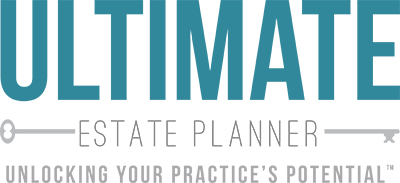SECURE 2.0 Act Enhances Special Needs—See Through Trust Planning
By Edwin P. Morrow, III, J.D., LL.M., MBA, CFP®, CM&AA® and Nancy H. Welber, J.D., ACTEC
Thanks to the generosity of Leimberg Information Services, we are pleased to provide you this recently published article on LISI.
EXECUTIVE SUMMARY
 Section 337 of the Secure 2.0 Act, effective in 2023, provides a welcome, though very limited in scope, enhancement to special needs trusts designed to receive retirement benefits and qualify as see through trusts under the Secure Act provision for applicable multi-beneficiary trusts (AMBTs).
Section 337 of the Secure 2.0 Act, effective in 2023, provides a welcome, though very limited in scope, enhancement to special needs trusts designed to receive retirement benefits and qualify as see through trusts under the Secure Act provision for applicable multi-beneficiary trusts (AMBTs).
The new provision provides that most charities can now be remainder beneficiaries after the death of a disabled or chronically ill beneficiary without disqualifying the trust as a see through trust.
Practitioners must be careful, however, to avoid naming disqualified charities such as private foundations or donor advised funds, or even spray provisions that would allow a trustee to later shift such benefits to them.
FACTS
Congress recently passed the SECURE 2.0 Act of 2022 as part of its 1,653-page consolidated spending bill, which became law 12/29/2022 as part of the Consolidated Appropriations Act, 2023.[1] SECURE 2.0 Act is a follow up, of course, to the SECURE Act passed in late 2019, and provides several dozen moderate tweaks and improvements to encourage retirement savings. Unlike the original SECURE Act, however, most of these enhancements will have no effect whatsoever on how a taxpayer might design or plan their beneficiary designation, estate or trust. The main exceptions to this are Section 327, concerning planning for surviving spouses, which is the subject of prior LISI Estate Planning Newsletter,[2] and Section 337, which is the subject of this newsletter.
Section 337 provides a welcome, though very limited in scope, improvement to special needs trusts for qualifying disabled or chronically ill beneficiaries designed to qualify as see through trusts.[3] The original SECURE Act created an exception to the 10-year rule for eligible designated beneficiaries, which includes those who are disabled or chronically ill.[4]
For this category of beneficiaries, there was also a special carve out for trusts for them, which the statute refers to as “applicable multi-beneficiary trusts” (AMBTs).[5] If a trust qualifies as an AMBT, it can use the old life expectancy rule for “stretching” the RMDs over the life of the eligible designated beneficiary, rather than use the 10-year rule now applicable to most beneficiaries, even though the AMBT would otherwise be classified as an “accumulation” rather than a “conduit” trust.
Unfortunately, the SECURE Act’s original definition of AMBTs did not include a trust if it named a charity to receive any portion of the trust assets after the disabled or chronically ill beneficiary’s death, because all the countable beneficiaries had to be “designated beneficiaries”, which in turn had to be individuals. This was disappointing to many families of disabled and chronically ill persons, because it is quite common for families to want to secondarily benefit a charity that is helping to cure or ameliorate the disabling illness or disease of the individual and others with like conditions.
SECURE 2.0 fixes this to allow charities as AMBT remainder beneficiaries without disqualifying the trust for the stretch based on the disabled/chronically ill beneficiary’s life expectancy.
Mostly.
This newsletter will quickly recap why a conduit trust won’t work, review the basics of the AMBT structure under the SECURE Act, show how the new SECURE 2.0 provision changes it, then note the exceptions and provide some drafting tips for qualifying AMBTs under the new provision.
Why Conduit Trusts for Disabled/Chronically Ill Rarely Work
The SECURE Act would allow any eligible designated beneficiary, including those who are disabled or chronically ill, to receive funds in a conduit trust and still receive the “stretch”. This may be an acceptable structure for other eligible designated beneficiaries, such as a surviving spouse or someone who is not more than 10 years younger than the owner/participant. However, it does not work well for any trust for a beneficiary that may seek to qualify for any government means-tested benefits such as Medicaid.[6] Trusts for such beneficiaries are often referred to as special needs trusts and must be discretionary trusts. A conduit trust is not discretionary it must mandate that any distributions from the plan/IRA be paid to or for the benefit of the beneficiary, and there would typically be annual RMDs as well.[7] Thus, Congress created a special exception for accumulation trusts for such beneficiaries.
Quick Recap of AMBTs as Eligible Designated Beneficiaries
The special provisions for applicable multi-beneficiary trusts (AMBTs) are unnecessarily complex, confuse many practitioners and still require clarification, but the nutshell is that if someone leaves retirement plan benefits to a trust that only benefits qualifying chronically ill/disabled beneficiaries during their lifetimes, the trust can accumulate distributions (referred to as an “accumulation trust”) and still qualify to use the old “stretch” distribution scheme, paying out required minimum distributions (RMDs) over the life expectancy of the eldest disabled/chronically ill beneficiary’s life expectancy. This is true even if the remainder beneficiaries are not “eligible designated beneficiaries”. Provided the beneficiary is younger than 80 or so, this is much better than the 10-year rule applicable to most situations, and much better than the 5-year rule or “ghost life expectancy” rule applicable when a trust as beneficiary does not qualify as a see through trust at all. If there are multiple disabled or chronically ill beneficiaries and the eldest disabled or chronically ill beneficiary dies before the beneficiary’s life expectancy payout runs out, the remaining disabled or chronically ill beneficiaries will continue the payout until the later of the death of the last disabled or chronically ill beneficiary, or the exhaustion of the retirement accounts payable to the AMBT.
Under the initial iteration of the SECURE Act, leaving even a dollar of accumulated retirement plan assets to charity when the disabled beneficiary dies (a remainder beneficiary) completely disqualifies the trust from being an AMBT. Not only might it be disqualified from being an AMBT, but it would also fail as a see through trust, and be forced to use the 5-year rule if the owner died before their required beginning date (RBD), the ghost life expectancy rule if the owner died after their RBD, or perhaps even have to take funds out within a one year if a qualified plan did not permit the trust to keep funds in the plan that long, since non-designated beneficiaries would not be permitted to rollover to an inherited IRA.[8]
For further discussions of AMBTs under the original SECURE Act, see Nancy Welber’s Trusts and Estates article or ACTEC podcast.[9]
AMBT Definition Pre-SECURE 2.0 and As Modified by SECURE 2.0
Re-reading the current statute is helpful to compare and understand what the SECURE 2.0 amendment will be changing. This is the 2020-2022 definition of AMBTs:
(v) Applicable multi-beneficiary trust. For purposes of this subparagraph, the term “applicable multi-beneficiary trust” means a trust:
(I) which has more than one beneficiary,
(II) all of the beneficiaries of which are treated as designated beneficiaries for purposes of determining the distribution period pursuant to this paragraph, and
(III) at least one of the beneficiaries of which is an eligible designated beneficiary described in subclause (III) or (IV) of subparagraph (E)(ii).
Remember, a charity cannot ordinarily be a “designated beneficiary”, who must be an individual. Section 337 of the SECURE 2.0 Act modifies this definition as follows [NB: bold comments in bracket added]:
SEC. 337. MODIFICATION OF REQUIRED MINIMUM DISTRIBUTION RULES FOR SPECIAL NEEDS TRUSTS.
(a) In General — Section 401(a)(9)(H)(iv)(II) is amended by striking “no individual” and inserting “no beneficiary”.
[NB: paragraph (H)(iv)(II) provided that:
“no individual (other than an eligible designated beneficiary described in subclause (III) or (IV) of subparagraph (E)(ii)) [disabled or chronically ill individuals] has any right to the employee’s interest in the plan until the death of all such eligible designated beneficiaries with respect to the trust”]
(b) Conforming Amendment.—Section 401(a)(9)(H)(v) is amended by adding at the end the following flush sentence:
“For purposes of the preceding sentence, in the case of a
trust the terms of which are described in clause (iv)(II),
any beneficiary which is an organization described in
section 408(d)(8)(B)(i) shall be treated as a designated
beneficiary described in subclause (II).”
(c) Effective Date.—The amendments made by this section shall apply to calendar years beginning after the date of the enactment of this Act. [NB: the date of enactment was 12/29/2022, so this will apply for calendar years beginning 2023]
COMMENT
Which Charities are Eligible AMBT Remainder Beneficiaries?
Thus, for purposes of AMBTs (and only for AMBTs), certain charities will be treated as “designated beneficiaries”. It is not all charities the reference above is to IRC §408(d)(8), which is the statute outlining the requirements for qualified charitable distributions from IRAs. Here is the code section referenced:
I.R.C. § 408(d)(8)(B)(i)—
which is made directly by the trustee to an organization described in section 170(b)(1)(A) (other than any organization described in section 509(a)(3) or any fund or account described in section 4966(d)(2)), and
The above definition includes public charities but excludes most private foundations and donor advised funds (DAFs). Thus, an AMBT cannot benefit such entities after the disabled/chronically ill beneficiary’s death. DAFs are an inexpensive favored option for many families, because it allows the family to reallocate funds to the charities making the most impact on the favored cause (often associated with aiding the disabled/chronically ill beneficiary). However, there is nothing in the law that would prevent a trust provision allowing the family to change remainder beneficiaries of an AMBT to other Section 408(d)(8)(B)(i) qualifying charities.
No Fix for Deaths in 2020-2021 — What about Deaths in 2022?
Unfortunately for those families where the owner died in 2020-2021, this fix only applies starting in 2023 and does not help any situations in which the retirement plan owners had died in prior years after the SECURE Act’s effective date.
If an IRA owner died in 2022 leaving assets to an AMBT for a disabled beneficiary, remainder to a qualifying charity, when Section 337 of the SECURE Act is ineffective, might it still be eligible under the new law because the beneficiary determination date would be September 30, 2023, after the effective date? Which date is relevant?
The relevant date for deaths in 2022 should be September 30, 2023, after the effective date of the new AMBT provision, because that is when the RMD scheme is determined. In fact, proposed regulations clarify that there would still be time to modify the trust until that date.[10] For example, if an IRA owner died in 2022, leaving an IRA in trust for a disabled beneficiary, with a portion of the remainder to a donor advised fund or private foundation, there should still be time to modify the trust to name a public charity instead. This may, of course, require cooperation from the DAF sponsor, private foundation or possibly even the state attorney general.
Drafting Tips – Clauses to Be Careful to Avoid
What if there is a clause (which would not be uncommon) allowing the family, trustee or trust protector to change the remainder charity to a broad category of charities that would include a non-qualifying organization? Would this disqualify the AMBT ab initio, or have a retroactive effect only later if such a change occurs and there are still funds in the plan?
Practitioners should be careful to limit such flexibility to only those charities qualifying under IRC Section 408(d)(8)(B)(i), especially if there is such a power held by a fiduciary. Non-qualifying charities that might be entitled to funds might be a countable beneficiary and therefore disqualify the AMBT, losing the stretch. Any such spray power or power to change charitable beneficiaries should be limited to only those charities that qualify under IRC Section 408(d)(8)(B)(i).
Broad powers of appointment held by non-fiduciaries should not be a problem, however. Assuming that the Proposed Regulations under the SECURE Act are finalized without further change, they clarified that we do not count a mere potential appointee of a non-fiduciary limited power of appointment as a countable beneficiary when identifying all the designated beneficiaries of a trust.[11] Mere potential appointees do not have any standing to contest trust matters as a general rule, but discretionary beneficiaries do.
Thus, if the settlor/family wants to be able to change the remaindermen of an AMBT to a private foundation or donor advised fund, they should make sure that this power is held by a non-fiduciary as a power of appointment. This would often be a family member, but it might be a trust protector effectively functioning as a non-fiduciary powerholder. Whether such a role is held as a fiduciary or not will depend on state law and potentially the trust instrument. Such power would have to only be exercisable after the death of the disabled/chronically ill beneficiary, when the disqualification of see through trust status may no longer matter. There is no reason under the tax law that the chronically ill/disabled beneficiary cannot be given a testamentary limited power of appointment in an AMBT.
The special needs trusts that we know qualify as AMBTs are considered “third-party supplemental needs trusts (SNTs).” They are established by someone other than the special needs beneficiary, typically a parent or another relative. Some trusts for special needs beneficiaries may include a clause allowing a trustee to transfer a trust to a pooled account trust established under 42 U.S.C. 1396(d)(4)(C), that is run by a non-profit organization, and are ordinarily used to manage funds for special needs beneficiaries who establish a supplemental needs trust using their own funds, such as an inherited IRA. It is considered a “first-party trust”.[12] The trustee of the trust establishes a pooled account for multiple special needs beneficiaries and can be a cost-effective way to provide services for special needs beneficiaries. At the death of a special needs beneficiary, the remainder goes to charity. A third-party special needs trust may include a clause allowing the trustee to transfer the trust assets to a pooled accounts trust for the special needs beneficiary if the current trust is no longer viable economically. Because the remainder beneficiary of the pooled account trust remainder beneficiary is a charity, some may think that a pooled accounts trust is now a viable option. It is not.
In order for an SNT to qualify as an AMBT, the trust must be a see-through trust with its own taxpayer identification so that the required minimum distributions payable to the SNT can be tracked and traced to the AMBT beneficiary or beneficiaries. (As noted, it is possible to have an AMBT with multiple disabled or chronically ill beneficiaries, although it may not be advisable unless the disabled or chronically ill beneficiaries are close in age.) Tracking is not possible in a pooled accounts trust. In the pooled accounts trust, the IRA would be pooled with the other beneficiary’s assets and then a separate account, but not a separate trust, would be established for the beneficiary’s share of the “pool”. Therefore, the inclusion of such a provision in an AMBT should either exclude the retirement benefits payable to the AMBT from a transfer to the pooled accounts trust or should allow the transfer only after the retirement accounts have been depleted.
Finally, in any SNT that is designed to hold retirement benefits, include a provision that makes clear that it is the settlor’s intention that the trust qualifies as an AMBT, and then give specific directions to the trustee in the trust instrument to guide the trustee in accomplishing that mission.
Conclusion
This is a welcome enhancement for families of disabled beneficiaries and the charities that assist them. Most families will not be bothered much by the restrictions regarding private foundations and donor advised funds, and can work with an attorney to build in substantial flexibility to mimic this flexibility through a clause permitting modification of the charities receiving any portion of funds left over after the disabled/chronically ill beneficiary’s death.
CITE AS:
LISI Estate Planning Newsletter #3027 (March 30, 2023) at http://www.leimbergservices.com. Copyright 2023 Edwin P. Morrow III, Nancy Welber and Leimberg Information Services, Inc. Reproduction in Any Form or Forwarding to Any Person Prohibited – Without Express Permission. This newsletter is designed to provide accurate and authoritative information regarding the subject matter covered. It is provided with the understanding that LISI is not engaged in rendering legal, accounting, or other professional advice or services. If such advice is required, the services of a competent professional should be sought.
CITES:
Consolidated Appropriations Act, 2023. Division T of the Act Contains the SECURE 2.0 Act of 2022.
CITATIONS:
[1] The text of the new changes and the link to the entire bill is here (skip to Section 337 of the bill, starting at page 915, for the amendment discussed in this newsletter).
[2] Ed Morrow: SECURE 2.0 Offers Longer Stretch for Conduit Trusts, but Contains Traps for Surviving Spouses, LISI Estate Planning Newsletter #3010 (January 24, 2023).
[3] See the Joint Committee of Taxation’s ESTIMATED REVENUE EFFECTS OF H.R. 2617, JCX-21-22 (December 22, 2022) which outlines the annual cost of the bill to the federal fisc (or to taxpayers if a revenue raiser). This provision is deemed to have negligible impact.
[4] IRC §401(a)(9)(E) defines these terms by reference to other code sections:
“(III)disabled (within the meaning of section 72(m)(7)),
(IV)a chronically ill individual (within the meaning of section 7702B(c)(2), except that the requirements of subparagraph (A)(i) thereof shall only be treated as met if there is a certification that, as of such date, the period of inability described in such subparagraph with respect to the individual is an indefinite one which is reasonably expected to be lengthy in nature), or”
[5] IRC §401(a)(9)(H)(iv) and (v) set out the definition and rules for AMBTs, which will be discussed herein.
[6] A conduit trust may work for wealthier families if Medicaid will never be needed for the beneficiary. However, there may be certain government-provided services that can only be accessed by the beneficiary if the beneficiary is on Medicaid so that even a family of great means may need their special needs family member to be receiving Medicaid to access these special services.
[7] Prop. Reg. 1.401(a)(9)-4(f)(1)(ii)(A).
[8] IRC §408(c)(11).
[9] For Nancy’s short ACTEC podcast on AMBTs in general, see https://actecfoundation.org/podcasts/SECURE-act-disabled-chronically-ill-beneficiaries/
[10] Prop. Reg. 1.401(a)(9)-4(f)(5).
[11] Prop. Reg. 1.401(a)(9)-4(f)(5)(ii).
[12] The status of Private Letter Ruling 200620025 (Feb 21, 2006), allowing the share of an IRA payable to a special needs individual to be transferred to a first-party special needs trust established under 42 U.S.C. 1396(d)(4)(A), is unclear under the proposed regulations. An ACTEC comment on the proposed regulations has asked for guidance as to whether a “(d)(4)(A) trust” would be considered an AMBT under the upcoming final regulations.
ABOUT THE AUTHOR
 Edwin P. Morrow, III, J.D., LL.M., MBA, CFP®, CM&AA® is a Wealth Strategist for Huntington National Bank, where he concentrates on thought leadership and planning ideas for high net worth clientele in tax, asset protection and estate planning areas. Ed was previously in private law practice working in taxation, probate, estate and business planning. Other experience includes research and writing of legal memoranda for the U.S. District Court of Portland, Oregon as a law clerk. He is a Fellow of the American College of Trust and Estate Counsel (ACTEC). He is a Board Certified Specialist (through the Ohio State Bar Assn) in Estate Planning, Trust and Probate Law, a Certified Financial Planner (CFP) professional and a Certified Merger & Acquisition Advisor (CM&AA). He is also a Non-Public Arbitrator for the Financial Industry Regulatory Authority (FINRA) and a member of the Editorial Advisory Board of the Probate Law Journal of Ohio. Ed is a frequent speaker at CLE/CPE courses on asset protection, tax and financial and estate planning topics, and recently co-authored, with Stephan Leimberg, Paul Hood, Martin Shenkman and Jay Katz, the 18th Edition of The Tools and Techniques of Estate Planning, a 997-page practice-based resource on estate planning.
Edwin P. Morrow, III, J.D., LL.M., MBA, CFP®, CM&AA® is a Wealth Strategist for Huntington National Bank, where he concentrates on thought leadership and planning ideas for high net worth clientele in tax, asset protection and estate planning areas. Ed was previously in private law practice working in taxation, probate, estate and business planning. Other experience includes research and writing of legal memoranda for the U.S. District Court of Portland, Oregon as a law clerk. He is a Fellow of the American College of Trust and Estate Counsel (ACTEC). He is a Board Certified Specialist (through the Ohio State Bar Assn) in Estate Planning, Trust and Probate Law, a Certified Financial Planner (CFP) professional and a Certified Merger & Acquisition Advisor (CM&AA). He is also a Non-Public Arbitrator for the Financial Industry Regulatory Authority (FINRA) and a member of the Editorial Advisory Board of the Probate Law Journal of Ohio. Ed is a frequent speaker at CLE/CPE courses on asset protection, tax and financial and estate planning topics, and recently co-authored, with Stephan Leimberg, Paul Hood, Martin Shenkman and Jay Katz, the 18th Edition of The Tools and Techniques of Estate Planning, a 997-page practice-based resource on estate planning.
 Nancy H. Welber of Nancy H. Welber, P.C., is an attorney in Farmington Hills and Ann Arbor, Michigan whose practice emphasizes estate planning and trust administration with retirement benefits. Nancy is a Fellow of the American College of Trust and Estate Counsel (ACTEC) and is a frequent lecturer and author on the topics of estate planning and trust administration with retirement benefits, including as a contributor to Trusts & Estates magazine. She is the long-time author, and now coauthor, of “Planning with Retirement Benefits” in the Michigan Estate Planning Handbook for the Institute of Continuing Legal Education.
Nancy H. Welber of Nancy H. Welber, P.C., is an attorney in Farmington Hills and Ann Arbor, Michigan whose practice emphasizes estate planning and trust administration with retirement benefits. Nancy is a Fellow of the American College of Trust and Estate Counsel (ACTEC) and is a frequent lecturer and author on the topics of estate planning and trust administration with retirement benefits, including as a contributor to Trusts & Estates magazine. She is the long-time author, and now coauthor, of “Planning with Retirement Benefits” in the Michigan Estate Planning Handbook for the Institute of Continuing Legal Education.
